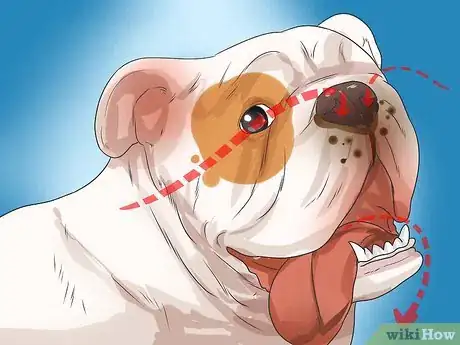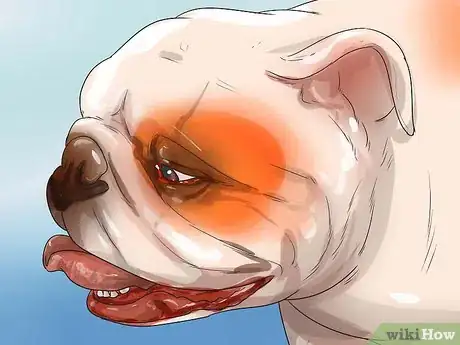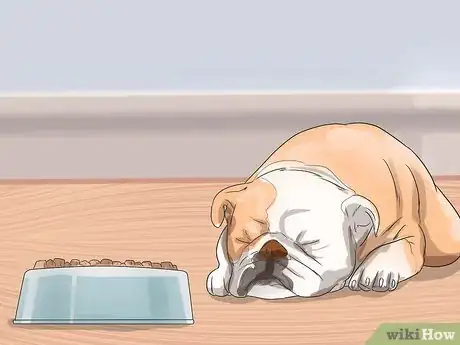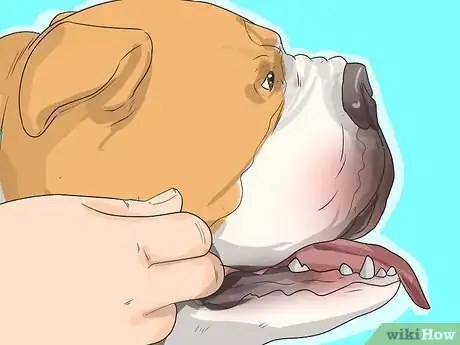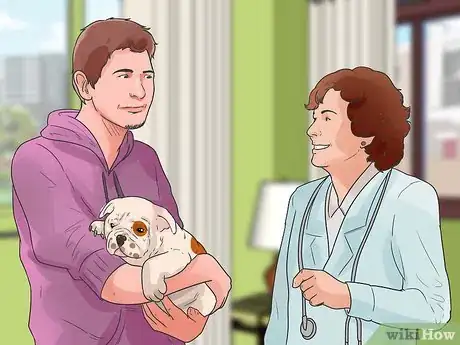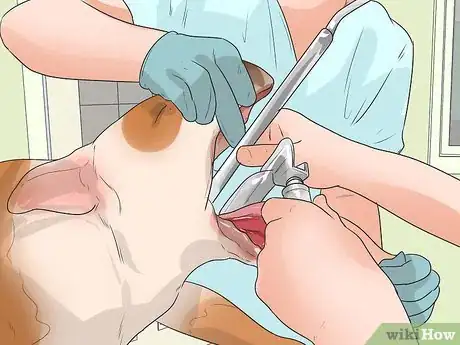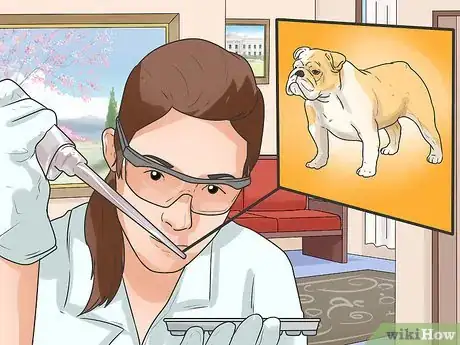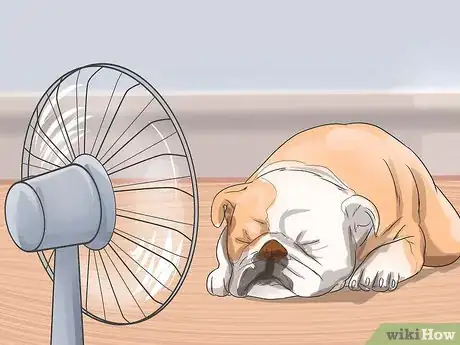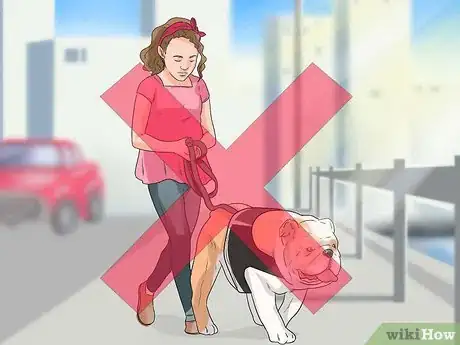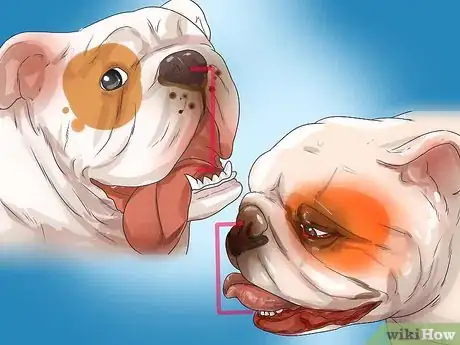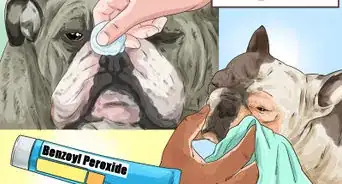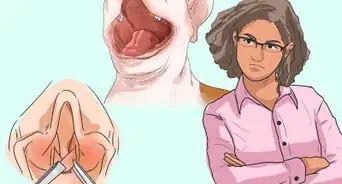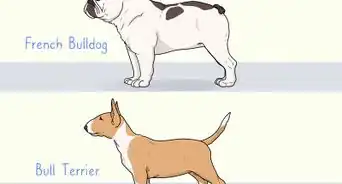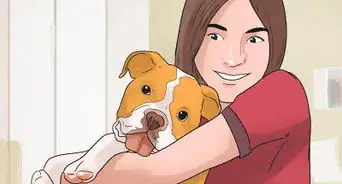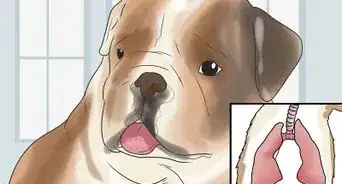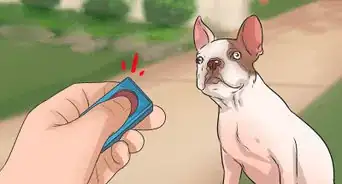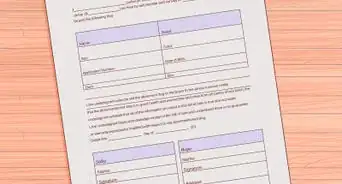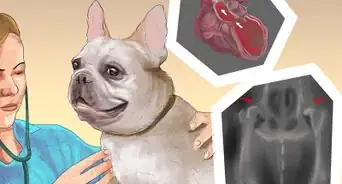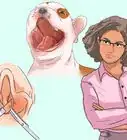This article was co-authored by David Schmucker. David Schmucker is a Dog Trainer and a Senior Trainer at Sidewalk Dog Training in Washington D.C. With over 17 years of experience, David specializes in canine training programs such as dog aggression training, dog behavioral correction, and dog separation anxiety training. David holds a BS in Personnel & Labor Management from the University of Maryland.
wikiHow marks an article as reader-approved once it receives enough positive feedback. In this case, 100% of readers who voted found the article helpful, earning it our reader-approved status.
This article has been viewed 65,341 times.
Bulldogs belong to a group of dogs with squished, flat faces. The official term for this is brachycephalic, which means having a fore-shortened head.[1] Cute as their flat faces are, the lack of a normal length nose causes all sorts of problems with the structure of the upper respiratory tract. Because of the shortened nose and upper airway, bulldogs are prone to breathing difficulties. Depending on the severity of the problem, these difficulties can be life threatening, so it is essential you recognize the signs and be able to diagnose of a respiratory problem if you own a bulldog.
Steps
Recognizing the Symptoms of Respiratory Problems
-
1Monitor for excessive panting. One of the main signs of respiratory problems for your bulldog is excessive panting. This means your dog will pant more than is normal or in situations where he shouldn’t be panting. He may be taking rapid shallow breaths.
- You may see his tongue hanging out, and he may have drool or saliva hanging from the jowls.
-
2Watch for any coughing. Your bulldog may exhibit other breathing issues in addition to panting. He may start coughing a lot. He also may start hacking, like he can’t get enough air or has something stuck in his throat.[2]
- Your bulldog also may start to choke due to the coughing or lack of air.
- Your bulldog may also snort or make snoring sounds when breathing.
Advertisement -
3Check for physical limitations. Because of the bulldog’s breathing problems, he may be unable to perform the same kind of physical activities that other dogs can. Heavy or excessive exercise may cause him to pant excessively. He may also just be unable to perform any physical activity at all.[3]
- Your dog may show more physical limitations in hot, humid weather.
-
4Look for any discomfort. Your dog may exhibit symptoms of discomfort due to his trouble breathing. Your dog may have a tense or worried expression on his face. He may also hold his head low with the neck straight. He also may refuse food.[4]
- Your dog may also be reluctant to move or walk.
- Your dog may also sit with the elbows held away from the body.
-
5Check for any signs of respiratory distress. Your dog’s trouble breathing may lead to some more serious symptoms. Your dog may have a blue tinge to the normally pink membranes in the mouth. This is evidence that he is having trouble getting oxygen.[5]
- Due to this distress, your dog may collapse with heavy breathing.
-
6Know that all bulldogs are prone to respiratory problems. Bulldogs are a breed considered brachycephalic. This means that the dog has a shortened head, and therefore, nasal passage. This causes bulldogs to have their signature smushed in face. However, this also leads to a life of respiratory problems.[6]
- The respiratory problems that affect the bulldog is referred to bracycephalic respiratory syndrome. This refers to the general respiratory problems that bulldogs have due to their upper airway abnormalities.
- Almost every bulldog suffers from some symptoms of bracycephalic respiratory syndrome. This means that monitoring for the following symptoms is especially important to protect your dog.
Diagnosing Respiratory Problems in Bulldogs
-
1Take your dog to the vet. If you see any or all of the symptoms of respiratory distress, then do not move your dog, except to carry him to the vet. The vet will examine the dog and listen to his chest with a stethoscope. This helps decide if the problem is in the chest or the upper airway.
- If the dog is severely distressed, the vet may give the dog treatment to stabilize his breathing and put him in an oxygen tent until he is out of danger.[7]
-
2Check the dog’s nose and throat. A visualize inspection can tell the vet about the dog's nostrils. Opening his mouth can show the vet if the mouth is crowded with tongue and soft palate that are blocking the back of the throat.[8]
- Your vet will probably press on the windpipe to get your dog to cough. He may also check the gums to look for discoloration to check for a lack of oxygen.
- Getting a clear view of the back of the throat requires an anesthetic. The vet then uses a laryngoscope to examine the soft palate, size of the tonsils, and how crowded the throat area is.
-
3Get other tests. The vet may do a blood test to determine if there are any underlying conditions that may be causing any respiratory distress, like infections. If your bulldog has an underlying infection, it may aggravate and worsen respiratory symptoms. In some cases, the vet may need to perform imaging tests to diagnose your bulldog. A CT scan or x-ray can visualize the size of the windpipe to check if it is too narrow or not.
- Your vet may also do an ultrasound to check the lungs and heart.
Dealing With Your Bulldog’s Respiratory Problems
-
1Be prepared for when your dog has respiratory difficulties. If you own a bulldog, you should be alert to the signs of breathing difficulty. When your dog faces any respiratory troubles, you will need to take steps to calm your dog and rest him so that his need for oxygen is less.
- When you see that your dog has respiratory distress, stop him from any physical activity immediately. Keep him calm so you can try to regulate his breathing.
- If you are outside, take your dog inside. If you can’t get inside quickly, get your dog into a cooler, shaded area.
- Place cool wet rags on your dog to help lower his body temperature.
-
2Reduce your dog’s respiratory distress. Since all bulldogs are at risk for respiratory problems, you can do things for your bulldog to help reduce the likelihood of him experiencing respiratory distress. One of the main things you can do is regulate your dog’s weight.[9] Being obese can put major stress on your dog’s respiratory system, causing breathing problems. Weight loss is one of the most common treatments to help respiratory problems in bulldogs.[10]
- Limit your dog’s heavy exercise and his excitability. These things lead to fast breathing and panting, which is more difficult for your bulldog.
- Keep your bulldog out of the heat. Excessive heat can worsen his breathing problems.[11]
-
3Recognize the respiratory problems a bulldog faces. One of the major problems for bulldogs is that the structure of the skull is made up of bone and soft tissue, and the size of the nose is reduced and flattened in this breed. Although bone is shortened, the soft tissue structures in the mouth, such as the tongue and soft palate, remain the same size as before. Due to this structure, the structural problems suffered by bulldogs include:
- Narrow nostrils. The nostrils of the bulldog are often narrow and either completely closed or mere slits, instead of having nice wide open nostrils like other breeds.
- Compressed nasal passages. The shortened bony case of the nose means the dog lacks the normal filtering mechanism of the nasal turbinates. Filtering serves to warm cold air when it's breathed in and to filter out dust.
- Long soft palate. A fleshy shelf called the soft palate divides the nose from the mouth. Given the shortened nature of the dog's nose and mouth, the soft palate takes up more room than it should and tends to block the entrance to the windpipe, causing choking episodes from time to time.
- Large tonsils. The dog's tonsils tend to enlarge to cope with the unfiltered area. The tonsils sit in the throat just above the entrance to the windpipe. When they are enlarged, they can restrict airflow into the windpipe.
- Narrow windpipes. Bulldogs have a syndrome where the windpipe has a narrower diameter, again making it hard to breathe.
Expert Q&A
-
QuestionWhy do bulldogs find it hard to breathe?
 David SchmuckerDavid Schmucker is a Dog Trainer and a Senior Trainer at Sidewalk Dog Training in Washington D.C. With over 17 years of experience, David specializes in canine training programs such as dog aggression training, dog behavioral correction, and dog separation anxiety training. David holds a BS in Personnel & Labor Management from the University of Maryland.
David SchmuckerDavid Schmucker is a Dog Trainer and a Senior Trainer at Sidewalk Dog Training in Washington D.C. With over 17 years of experience, David specializes in canine training programs such as dog aggression training, dog behavioral correction, and dog separation anxiety training. David holds a BS in Personnel & Labor Management from the University of Maryland.
Dog Trainer Bulldog breeding has gotten to a point where no bulldogs are born naturally anymore—they're born by cesarean section since their heads are too large to move through the pelvic region. So, all those folds and extra skin around the face (as well as the short muzzle) cause the breathing to be inhibited.
Bulldog breeding has gotten to a point where no bulldogs are born naturally anymore—they're born by cesarean section since their heads are too large to move through the pelvic region. So, all those folds and extra skin around the face (as well as the short muzzle) cause the breathing to be inhibited.
References
- ↑ http://www.merckvetmanual.com/pethealth/dog_disorders_and_diseases/lung_and_airway_disorders_of_dogs/introduction_to_lung_and_airway_disorders_of_dogs.html
- ↑ http://www.vcahospitals.com/main/pet-health-information/article/animal-health/brachycephalic-airway-syndrome-in-dogs/2143
- ↑ http://www.petmd.com/dog/conditions/respiratory/c_multi_brachycephalic_airway_syndrome
- ↑ http://www.vcahospitals.com/main/pet-health-information/article/animal-health/brachycephalic-airway-syndrome-in-dogs/2143
- ↑ http://www.vcahospitals.com/main/pet-health-information/article/animal-health/brachycephalic-airway-syndrome-in-dogs/2143
- ↑ http://www.vcahospitals.com/main/pet-health-information/article/animal-health/brachycephalic-airway-syndrome-in-dogs/2143
- ↑ http://www.petmd.com/dog/conditions/respiratory/c_multi_brachycephalic_airway_syndrome?page=2
- ↑ http://www.vcahospitals.com/main/pet-health-information/article/animal-health/brachycephalic-airway-syndrome-in-dogs/2143
- ↑ http://www.petmd.com/dog/conditions/respiratory/c_multi_brachycephalic_airway_syndrome
About This Article
To diagnose respiratory problems in bulldogs, monitor your pet for excessive panting or rapid shallow breaths, which are common symptoms of a respiratory issue. In addition to panting, your dog may cough or hack a lot. If your dog’s breathing troubles are causing discomfort, it may be reluctant to move, sit with its elbows away from its body, or appear stressed. If you see any signs of respiratory distress in your dog, take it to the vet for an exam and treatment. For more information from our Veterinary co-author, like how to reduce your dog’s respiratory distress, keep reading!
